Falling for Tautog
Ken Neill
Published in Chesapeake Angler
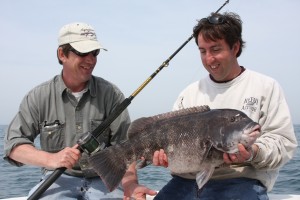 Fall is a fabulous time for fishing. Our warm water fish go on a feeding freezing as they leave to their way to their wintering grounds. Our cold water fisheries turn on as the waters cool. One of my favorite of these is the tautog. Tautog are in our area all year but it is in the Fall through Spring that these fish are most available to anglers.
Fall is a fabulous time for fishing. Our warm water fish go on a feeding freezing as they leave to their way to their wintering grounds. Our cold water fisheries turn on as the waters cool. One of my favorite of these is the tautog. Tautog are in our area all year but it is in the Fall through Spring that these fish are most available to anglers.
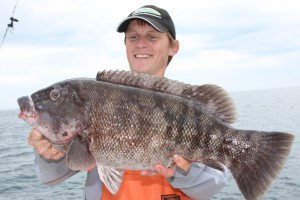 Most of our fisheries are related to “structure” of some kind. Channel edges, temperature brakes, tidelines, and other “changes” concentrate bait and the fish we target. Tautog take this structure thing to an extreme. They don’t just associate with structure, they burrow inside and squeeze into it. To fish for tautog, you need to get your baits into them and somehow, get the fish out of the structure after you get it hooked up.
Most of our fisheries are related to “structure” of some kind. Channel edges, temperature brakes, tidelines, and other “changes” concentrate bait and the fish we target. Tautog take this structure thing to an extreme. They don’t just associate with structure, they burrow inside and squeeze into it. To fish for tautog, you need to get your baits into them and somehow, get the fish out of the structure after you get it hooked up.
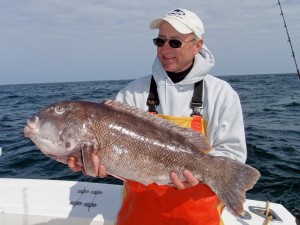 The structures of the numerous wrecks, artificial reefs, and the manmade fish attracting device, the Chesapeake Bay Bridge Tunnel all provide prime habitat for tautog to call home. Earlier in the fall, structures in the bay and those close to the oceanfront are usually the hot spots. As we move closer to winter and the waters cool further, wrecks further off of the coast become the favored locations for tautog anglers. It all depends on water temperature. Some years, tautog will remain active inside the bay all winter. Somewhere around 44 degrees seems to be the bay’s turn on/off point. Below that, you will need to travel out into the ocean to find active fish. Bay structures can be productive when the water temperatures are at least 44 degrees. The bay tautog bite will be more active with water temperatures a bit higher, 46-50 degrees.
The structures of the numerous wrecks, artificial reefs, and the manmade fish attracting device, the Chesapeake Bay Bridge Tunnel all provide prime habitat for tautog to call home. Earlier in the fall, structures in the bay and those close to the oceanfront are usually the hot spots. As we move closer to winter and the waters cool further, wrecks further off of the coast become the favored locations for tautog anglers. It all depends on water temperature. Some years, tautog will remain active inside the bay all winter. Somewhere around 44 degrees seems to be the bay’s turn on/off point. Below that, you will need to travel out into the ocean to find active fish. Bay structures can be productive when the water temperatures are at least 44 degrees. The bay tautog bite will be more active with water temperatures a bit higher, 46-50 degrees.
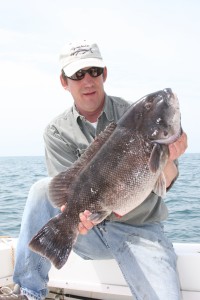 Whatever structure you choose to fish, you need to fish in it. For tautog, close is not close enough. Positioning your boat directly over the structure is critical for tog fishing. The most common way to do this is to use a grappling style, wreck anchor to snag the actual structure. These anchors come in different sizes for different boats. You want one that is strong enough to hold your boat but one that is not too strong for you to straighten the tines on when you are ready to un-anchor. Location, location, location…positioning really is everything. We will anchor up and then drop down to feel what is under us with our fishing lines. If we are not feeling good structure, we will do it again, moving until we feel good structure.
Whatever structure you choose to fish, you need to fish in it. For tautog, close is not close enough. Positioning your boat directly over the structure is critical for tog fishing. The most common way to do this is to use a grappling style, wreck anchor to snag the actual structure. These anchors come in different sizes for different boats. You want one that is strong enough to hold your boat but one that is not too strong for you to straighten the tines on when you are ready to un-anchor. Location, location, location…positioning really is everything. We will anchor up and then drop down to feel what is under us with our fishing lines. If we are not feeling good structure, we will do it again, moving until we feel good structure.
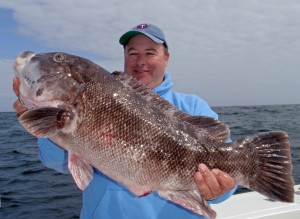 Tackle requirements are simple. You need a rod and reel with enough power to move the fish out of the structure and to keep it out. The rod needs to be sensitive enough to feel a bite that can be subtle at times. Braided fishing line is pretty much universally used today though there have been many tog caught on monofilament. You are going to lose terminal tackle. Most tautog anglers will tie their own rigs out of 50-60 pound test monofilament or fluorocarbon. A single dropper loop for your hook is tied closely above a loop for your hook. Another loop is tied at the top of your leader to attach your main fishing line. Hook size will vary with the size of the bait you are using and the size of the tautog you are fishing for. In general, hook sizes will range from 1/0 to 5/0.
Tackle requirements are simple. You need a rod and reel with enough power to move the fish out of the structure and to keep it out. The rod needs to be sensitive enough to feel a bite that can be subtle at times. Braided fishing line is pretty much universally used today though there have been many tog caught on monofilament. You are going to lose terminal tackle. Most tautog anglers will tie their own rigs out of 50-60 pound test monofilament or fluorocarbon. A single dropper loop for your hook is tied closely above a loop for your hook. Another loop is tied at the top of your leader to attach your main fishing line. Hook size will vary with the size of the bait you are using and the size of the tautog you are fishing for. In general, hook sizes will range from 1/0 to 5/0.
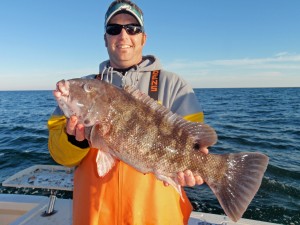 Tautog will eat a large variety of crustaceans and mollusks. Area favorite baits are blue crab, fiddler crab, and chowder clams but use your imagination. A variety of baits is good to have as on any given day, togs can seem to favor one over the other. If I had to pick one bait, it would be clam. Fiddler crabs seem to work better in the bay than out in the ocean. The recent Virginia record tautog was caught on a chunk of blue crab. Hermit crabs, conch, mole crabs, mud crabs, green crabs, and any other crab you can think of and even lobster can be used as tog bait.
Tautog will eat a large variety of crustaceans and mollusks. Area favorite baits are blue crab, fiddler crab, and chowder clams but use your imagination. A variety of baits is good to have as on any given day, togs can seem to favor one over the other. If I had to pick one bait, it would be clam. Fiddler crabs seem to work better in the bay than out in the ocean. The recent Virginia record tautog was caught on a chunk of blue crab. Hermit crabs, conch, mole crabs, mud crabs, green crabs, and any other crab you can think of and even lobster can be used as tog bait.
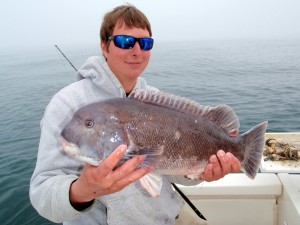 There is a saying that to catch a tog, you have to set the hook before it bites. That may have been true with monofilament fishing line but with today’s braided lines, I think this saying needs to be put to rest. I see more fish missed by setting the hook too soon than by reacting too late. When you first feel the fish nibble your bait, hesitate just a moment. Let the fish have a chance to get your hook in its mouth, but not long enough to pull your tackle further into the structure. It is tricky and they will bite differently on different days and tides. With experience, you will develop a feel for it, but in general just a slight hesitation and then set the hook. Set the hook and keep the fish coming up. Particularly if you have hung onto a big fish, you have a brief chance to get that fish out of structure and keep that rod tip up if you want to keep it from getting back into it.
There is a saying that to catch a tog, you have to set the hook before it bites. That may have been true with monofilament fishing line but with today’s braided lines, I think this saying needs to be put to rest. I see more fish missed by setting the hook too soon than by reacting too late. When you first feel the fish nibble your bait, hesitate just a moment. Let the fish have a chance to get your hook in its mouth, but not long enough to pull your tackle further into the structure. It is tricky and they will bite differently on different days and tides. With experience, you will develop a feel for it, but in general just a slight hesitation and then set the hook. Set the hook and keep the fish coming up. Particularly if you have hung onto a big fish, you have a brief chance to get that fish out of structure and keep that rod tip up if you want to keep it from getting back into it.
 Tautog have made many a fisherman say bad words and want to throw their tackle in the water but for many of us, they are addictive.
Tautog have made many a fisherman say bad words and want to throw their tackle in the water but for many of us, they are addictive.

Hey Ken, we caught a big one yesterday at the salty dog yesterday. Do you know what the current state leader is for tautog, don’t worry it’s under 24 pounds!!! Lol
Bill
No I do not. They are slow getting going on this year’s citations. The largest we have caught this year is 13 pounds. If yours is larger than that, you very well may have the state lead. Ken
With the digital hand scales it was 18+!! We are going to weigh him in at the fishing center and I will give you the official #. She wants to get him mounted. Dave Saunders did my Gar, do you recommend anyone local?
Bill
That is a big one. Dave Saunder’s did my state record and it came out great. I don’t think you will find anyone better.